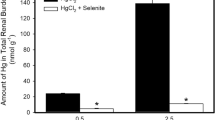Abstract
Selenium–mercury interactions were most extensively studied in relation to alleviation of Hg toxicity by added selenium. This presentation considers the influence of mercury on endogenous selenium, on its tissue and cellular “status” after lifelong or acute exposure to mercury vapor (Hgo). Discussed are data obtained from (1) humans living near or working in a mercury mine, and (2) rats experimentally exposed in the mine. Mercury vapor is unique—or similar to methylmercury—because of its ability to penetrate cell membranes and so invade all cells, where it is oxidized in the biologically active form (Hg++) by catalase. Such in situ-generated ions can react with endogenously generated highly reactive Se metabolites, like HSe−, and render a part of the selenium unavailable for selenoprotein synthesis. Data on human populations indicate that in moderate Hg exposure combined with an adequate selenium supply through diet, Se bioavailability can be preserved. On the other hand, the results of an acute exposure study emphasize the dual role of selenium in mercury detoxification. Besides the well-known Se coaccumulation through formation of nontoxic Hg–Se complexes, we observed noticeable Se (co)excretion, at least at the beginning of exposure. The higher Hg accumulation rate in the group of animals with lower basal selenium levels can also point to selenium involvement in mercury excretion. In such conditions there is a higher probability for decreased selenoprotein levels (synthesis) in some tissues or organs, depending on the synthesis hierarchy.





Similar content being viewed by others
References
Parizek J, Ostadalova I (1967) Experientia 23:142–143
Koeman JH, Peters WHM, Koudstaal-Hol CHM, Tijoe S, de Goeij JJM (1973) Nature 245:383–384
Nigro M, Leonzio C (1996) Mar Ecol Prog Ser 135:137–143
Kosta L, Byrne AR, Zelenko V (1975) Nature 254:238–239
Falnoga I, Tusek-Znidaric M, Horvat M, Stegnar P (2000) Environ Res 84:211–218
Nylander M, Weiner J (1989) Br J Ind Med 46:750–752
Weiner J, Nylander M (1991) Br J Ind Med 48:729–734
Shirabe T, Eto K, Takeuchi T (1979) Neurotoxicology 1:349–356
Drasch G, Wanghofer E, Roider G, Strobach S (1996) J Trace Elem Med Biol 10:251–254
Kosta L, Byrne AR, Zelenko V, Stegnar P, Dermelj M, Ravnik V (1974) Vestnik SDK 21:49–76 (in English)
Koeman JH, van de Ven WSM, de Goeij JJM, Tjioe PS, van Haaften JL (1975) Sci Total Environ 3:279–287
Nakamuro K, Okunoi T, Hasagawa T (2000) J Health Sci 46:418–421
Yoneda S, Suzuki KT (1997) Toxicol Appl Pharmacol 143:274–280
Gailer J (2007) Coord Chem Rev 251:234–254
Danscher G, Stoltenberg M (2006) Prog Histochem Cytochem 41:57–140
Drasch G, Mailander S, Schlosser C, Roider G (2000) Biol Trace Elem Res 77:219–230
Jacob C, Giles GI, Giles NM, Sies H (2003) Angew Chem Int Ed 42:4742–4758
Aoi T, Higuchi T, Kikodoro R, Fukumura R, Yagi A, Ohguchi S, Sasi A, Hayashi H, Sakamoto N, Hanaichi T (1985) Hum Toxicol 4:637–642
Falnoga I, Tušek-Žnidarič M, Milačič R (1998) Acta Chim Slov 45:229–237
Björkman L, Palm B, Nylander M, Nordberg M (1994) Biol Trace Elem Res 40:255–265
Falnoga I, Tušek-Žnidarič M, Stegnar P (2006) BioMetals 19:283–294
Kotnik J, Horvat M, Dizdarevič T (2005) Athm Environ 39:7570–7579
Falnoga I, Kobal AB, Stibilj V, Horvat M (2002) Biol Ttrace Elem Res 89:25–33
Kobal AB, Horvat M, Prezelj M, Sešek-Briški A, Krsnik M, Dizdarevič T, Mazej D, Falnoga I, Stibilj V, Arnerič N, Kobal-Grum D, Osredkar J (2004) J Ttrace Eleme Med Biol 17:261–274
Burk RF, Hill KE (2005) Annu Rev Nutr 25:215–235
Tan D-X, Manchester LC, Terron MP, Flores LJ, Reiter RJ (2007) J Pineal Res 42:28–42
Byrne AR, Kosta L (1975) Talanta 21:1083
Magos L, Halbach S, Clarkson TW (1978) Biochem Pharmacol 27:1373–1377
Schomburg L, Reise C, Michaelis M, Griebert E, Klein MO, Sapin R, Schweizer U, Koherle J (2006) Endocrinology 147:10306–10313
Richardson DR (2005) Biochem J 386(Pt 2):e5–e7
Schweizer U, Streckfuss F, Pelt P, Carlson BA, Hatfield DL, Köherle J, Schomburg L (2005) Biochem J 386:221–226
Bulato C, Bosello V, Ursini F, Maiorino M (2007) Free Radic Biol Med 42:118–123
Acknowledgements
The authors wish to thank to the whole group working on Idrija mercury subject during the last 40 years:
Dr. Alfred B. Kobal—researcher and medical doctor responsible for the health of miners after the Second World War until the closer of mine; Dr. Anthony R. Byrne—responsible for radiochemistry, development, and application of analytical techniques for Hg and Se, a coauthor of the first publication about Hg and Se coaccumulation in molar ratio 1:1 in human organs [4]; Dr. Peter Stegnar—former head of department and our Ph.D. supervisor and Dr. Mirjana Škreblin—working on metabolism of mercury in man, animals and plants; Nuša Prosenc—for Hg, Se determinations by RNAA; Dr. Milena Horvat—present head of department and expert for biogeochemical cycling and analytical chemistry of Hg; and Dr. Sitibilj Vekoslava—expert for selenium speciation.
Their work was published in several publications and is cited in the present article.
Author information
Authors and Affiliations
Corresponding author
Rights and permissions
About this article
Cite this article
Falnoga, I., Tušek-Žnidarič, M. Selenium–Mercury Interactions in Man and Animals. Biol Trace Elem Res 119, 212–220 (2007). https://doi.org/10.1007/s12011-007-8009-3
Published:
Issue Date:
DOI: https://doi.org/10.1007/s12011-007-8009-3




